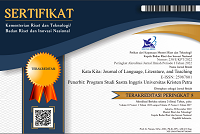Sociocultural-Interactive Learning Strategies Employed by Students of Social Science and Engineering Studies
DOI:
https://doi.org/10.9744/katakita.7.1.109-115Keywords:
Rumah Makan Ramayana, Makanan Khas Cina, Brand, Branding, Diferensiasi, Logo, Kemasan.Abstract
This study aims to find how frequently employed are Sociocultural-Interactive (SCI) learning strategies by high-proficiency students of English for Academic Purpose at Petra Christian University in Surabaya, Indonesia. The study’s theoretical framework is from Oxford’s (2011) S2R Model. To know the employment frequency of the strategies, questionnaire was distributed to 33 students classified as high-proficiency students. These students were divided into two groups based on the fields of study: social science and engineering. Descriptive statistics was used to see which strategy is more frequently used. Furthermore, to see if there is a significant statistical difference between the two groups, Independent T Test was conducted. The findings suggested that although, in general, social science students used SCI strategies more frequently, there was no significant statistical difference between the two groups regarding their employment of the strategies. Additionally, the findings revealed the SCI strategies have not been maximally used in learning English.
Keywords: learning strategies, sociocultural-interactive, high-proficiency, fields of study
References
Bialystok, E., & Smith, M. S. (1985, January 1). Interlanguage is not a state of mind: An evaluation of the construct for second-language acquisition. Applied Linguistics, 6(2), 101–117. doi:https://doi.org/10.1093/applin/6.2.101
Cheng, X. L., Xu, K., & Ma, Y. (2007). A Survey of Engineering Student’s Use of English Language Learning Strategies. The Journal of Asia TEFL, 4. Retrieved September 2, 2018, from http://www.asiatefl.org/main/download_pdf.php?i=302&c=1419313915
Dörnyei, Z. (2007). Research methods in applied linguistics: Quantitative, qualitative, and mixed methodologies. Oxford: Oxford University Press
Ellis, R. (2005). Measuring implicit and explicit knowledge of a second language. A psychometric study. Studies in Second Language Acquisition, 27, 141-172.
Finegan, E. (2004). Language: Its Structure and Use (Fifth ed.). Michael Rosenberg. Retrieved October 2, 2018, from http://staffnew.uny.ac.id/upload/132107096/pendidikan/Book+one+for+Int.pd f
Gerami, M. H., & Baighlou, S. M. (2011). Language Learning Strategies Used by Successful and Unsuccessful Iranian EFL Students. Procedia - Social and Behavioral Sciences, 29, 1567- 1576. Retrieved December 3, 2018, from https://www.sciencedirect.com/science/article/pii/S1877042811028667
Oxford, R. L. (2003). Language learning styles and strategies: an overview. Retrieved April 29, 2018,from http://web.ntpu.edu.tw/~language/workshop/read2.pdf
Oxford, R. L. (2011). Teaching and Researching Language Learning Strategy. New York: Longman
Schmidt, R. (2010). Attention, awareness, and individual differences in language learning. Retrieved October 2, 2018, from http://nflrc.hawaii.edu/PDFs/SCHMIDT%20Attention%2C%20awareness%2 C%20and%20individual%20differences.pdf
Downloads
Published
Issue
Section
License
Authors who publish with this journal agree to the following terms:- Authors retain copyright and grant the journal right of first publication with the work simultaneously licensed under a Creative Commons Attribution License that allows others to share the work with an acknowledgement of the work's authorship and initial publication in this journal.
- Authors are able to enter into separate, additional contractual arrangements for the non-exclusive distribution of the journal's published version of the work (e.g., post it to an institutional repository or publish it in a book), with an acknowledgement of its initial publication in this journal.
- Authors are permitted and encouraged to post their work online (e.g., in institutional repositories or on their website) prior to and during the submission process, as it can lead to productive exchanges, as well as earlier and greater citation of published work (See The Effect of Open Access).














